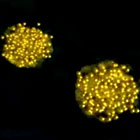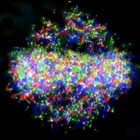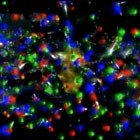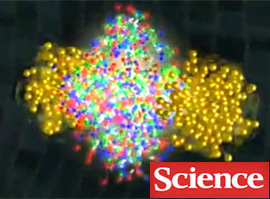




A New Area of Physics
RHIC has created a new state of hot, dense matter out of the quarks and gluons that are the basic particles of atomic nuclei, but it is a state quite different and even more remarkable than had been predicted. Instead of behaving like a gas of free quarks and gluons, as was expected, the matter created in RHIC's heavy ion collisions is more like a liquid.

Gluons and quarks

Ions about to collide

Just after collision

The "perfect" liquid
A "Perfect" Liquid
RHIC scientists had expected collisions between two beams of gold nuclei to mimic conditions of the early universe and produce a gaseous plasma of the smallest components of matter — the quarks and gluons that make up ordinary protons and neutrons. But instead of behaving like a gas, the early-universe matter created in RHIC’s energetic gold-gold collisions appears to be more like a liquid. And it’s not just any liquid, but one with coordinated collective motion, or “flow,” among the constituent particles.
Scientists describe this fluid motion as nearly “perfect” because it can be explained by the equations of hydrodynamics for a fluid with virtually no viscosity, or frictional resistance to flow. In fact, the high degree of collective interaction and rapid distribution of thermal energy among the particles, as well as the extremely low viscosity in the matter being formed at RHIC, make it the most nearly perfect liquid ever observed.
More about the "Perfect" LiquidQuark-Gluon Plasma
RHIC’s perfect liquid also turns out to be the hottest matter ever created in a laboratory, measuring some 4 trillion degrees Celsius, or 250,000 times hotter than the center of the Sun. That’s far above the temperature at which protons and neutrons melt to free their constituent quarks and gluons, showing definitively that RHIC’s perfect liquid is hot enough to be the long-sought quark-gluon plasma.
Scientists measure the temperature of hot matter by looking at the color, or energy distribution, of light emitted from it — similar to the way one can tell that an iron rod is hot by looking at its glow. Because light interacts very little with the hot liquid produced at RHIC, it bears accurate witness to the early cauldron-like conditions created within. More...
String Theory
There is an emerging connection between the collider's results and calculations using the methods of string theory, an approach that attempts to explain fundamental properties of the universe using 10 dimensions instead of the usual three spatial dimensions plus time. For example, string theory predicts a fundamental quantum lower limit on the viscosity of any relativistic fluid -- a limit approached very closely by the nearly perfect quark-gluon liquid created in RHIC collisions. More...
Exotic Findings
RHIC’s quark-gluon plasma exhibits other unusual properties that have intrigued scientists. Tiny “bubbles” formed within this hot soup may internally disobey fundamental symmetries that normally characterize the interactions of quarks and gluons. These first hints of symmetry violations at RHIC suggest that scientists may now have a unique opportunity to test in the laboratory some crucial features of symmetry-altering bubbles speculated to have played important roles in the evolution of the infant universe. More...
RHIC collisions have also produced the heaviest antimatter nucleus yet discovered, and the first containing an anti-strange quark. This discovery of exotic antimatter at RHIC extends physicists’ “map” of nuclei into a new frontier. It may help elucidate models of neutron stars, and also opens another way to explore fundamental asymmetries in the early universe. More...

